By the Currelly sisters, Nancy, Patsy and Carol
Women’s softball began in Cobourg on Labour Day, in 1926. Mrs. Arthur Bulger gathered a group of girls for a last-minute game against a visiting team from Toronto. Long skirts were the attire for the game. Cobourg won and the history of girls’ softball began.
In 1928, a church league was formed; this included St. Andrew's, Trinity, St. Michael's, Baptist and St. Peter’s. This league continued to run until the mid 1930s. In 1931, a new girl’s team was formed. It was initially called the Cobourg Lakesides but later in the season they changed the name to the Cobourg All-Stars. They played in a league which included Peterborough, Bowmanville, Baltimore and Bailieboro.
The Cobourg All-Stars were highly successful and ended the season with 26 wins and 0 losses. The highlight of the year was an exhibition game held at Victoria Park, on Labour Day, against the Toronto Lansing Athletic Club who were Intermediate League champions. Cobourg beat them 8-7 in the bottom of the 9th.
Members of this team included: Rita Oliver (P), Helen Slater(C), Grace Maher(3B), Felicia Brinning (SS), Marion Clapper (2B &CF), M. Harper (RF), Agnes Mundy (CF), Dorothy Sloper (2B), Lillian Roberts (1B), Marion Ovens (LF), D. Sloper (P), H. Mann (C), K. Turpin(CF), H. Campbell (2B), Helen Pellow (RF), Ms. Lean. This team was celebrated for their accomplishments by the town and a banquet was held in their honour, where the Mayor stated the ball players had “put Cobourg on the map in Sports” (Cobourg Sentinel Star, Sept.17, 1931).
The tradition of hosting Toronto teams on Labour Day continued until the mid 1940’s. As there was no established provincial play-off, the Cobourg All-Stars team reached the highest pinnacle they could achieve. (The provincial women’s softball association/union (PWSU/PWSA) began in 1931 and until 1942 only had an Intermediate A division).
In 1932, softball flourished. The inter-church league continued and the Cobourg All-Stars played in a league with Port Hope, 2 Peterborough teams, Keene, Lakefield, and Belleville. They also played games against Kingston and the Toronto Alerts, beating both. It appears that star pitcher Rita Oliver from Cobourg played for Port Hope this season, reason unknown, and Helen Slater became the main pitcher for Cobourg. In 1933, there is the first mention of the Hamilton Township League including teams from Gores Landing, Harwood, Camborne, Baltimore and Plainville. The Cobourg All-Stars played in a league against Belleville, Peterborough and Kingston.
In 1936, there were three women’s softball leagues – the Cobourg Inter-Church League, the Lakeshore League and the Hamilton Township League. Under the direction of “Hoot” Gibson, the Cobourg Combines (rep team) were looking strong. Reta Slater was their star pitcher, who not only pitched but also helped with the finances and transportation. The team played in the Lakeshore League against Bowmanville and Oshawa and lost to Oshawa in the playoffs. They had a successful season with exhibition game wins against Peterborough, Keene and the Hamilton Township Champion, Gores Landing.
With WWII spanning from 1939-45, there was not much documentation during most of those years. 1944 brought a strong presence of Girls Softball in the area. There was a Girls Softball Town League flourishing in Cobourg including both minor and senior divisions. Some of the teams were: the Ontario Training School Gliders, Campbell’s, Cooey’s, CYO (Catholic Youth Organization), Matting, Cobourg Lumber Company, Mrs. Pender’s Schoolgirls, Fowlers Wholesale, and Shaw’s Shamrocks. There was also a rep team called the Cobourg Combines. These teams continued to play throughout 1945.
Girls softball was a popular past-time in 1946. There were opportunities to play in the Intermediate Lakeshore League and the local town league. In the town league was Cobourg Lumber, Cooey’s Arms, Shaws Shamrocks, The Ontario Training School and Fowler’s Wholesale. Playing in the “rep” league were the Cobourg Towne Cleaners, Collacutt, Port Hope Bata Shoe, Colborne, CYO and Shaw Combine. The Cobourg Towne Cleaners were the successful winners out of the league with a record of 11 wins and 1 loss. As a result, they qualified to compete for the provincial title.
They won the Eastern Ontario Intermediate Championship. They beat Belleville in 2 straight wins but lost to Toronto Crofton’s at the Provincials. Members of this team, coached by Lorne (Bus) Cane and Frank Hubbs and managed by Alf Minaker, were: Reta Slater, Pat Harnden (Kernaghan), Ruth Brooks (Minifie), Evelyn Brisbin (Heriot), Winnie Twitchett (Smith), Shirley Harnden (Johnston), Ruth Stillwell (Medurst), Maizie Jenkinson, Alice Guy (Wilson), Jean Allen, Ivy Cockburn, Ruth Bolderstone (Cane), Jackie Kadan, Ilene Goody (Cherry) and mascot Marilyn Jenkinson.
The number of teams playing in 1947 reflects 1946 however there was a new team named The Cobourg Pavilions. They were an Intermediate B team playing in the Lakeshore League with Grafton, Colborne, 2 Port Hope teams, Peterborough and Trenton. The “Pavs” played Port Hope in the final playoff of this league to earn the berth into the provincial playoffs. They met Port Credit in the first round and beat them.
They were to play Newmarket next. However, because of a violation of a rule which stipulated the league playoffs (vs Port Hope), had to be completed 48 hours before beginning provincial playoffs, they are disqualified (the violation occurred because of scheduling difficulties due to weather and schooling). Most of the girls were at the park in Newmarket when they heard of the protest by Port Credit thereby ending their season.
The Lakeshore League and Church League continued to thrive in 1948. There were 3 Cobourg rep teams playing that year - CGE, the Pavs and Shaws Shamrocks. This was the first year mentioned that the girls were playing under the lights at Victoria Park. The teams in the Lakeshore League were: 3 Cobourg teams, Peterborough, Grafton and Colborne. The Pavilions won this league under the direction of Bus Cane. Eleanor Brown pitched a perfect game during regular season play against CGE (walks 1 – the score 41-0). The Pavs beat Grafton to go into the Provincial Playdowns. They beat Lindsay in the first round, Newmarket in the second and Midland in the third round. They proceeded to the semi-finals but lost the next round to Welland (1W and 2L) on September 16, 1948.
The 1949 season was a repeat of the previous year with the Pavs winning the League. The Baltimore Blue Birds join the Lakeshore league, the Pavs won the league against Grafton and proceeded to beat Newmarket and Belleville in Provincial playoffs but then lost to Midland in 2 straight games. The Hamilton Township Girls Softball League was active and included teams from Precious Corners, Cold Springs, Plainville and Harwood.
In 1950, Thomas “Shammy” Shaw became the new President of the Lakeshore League. He actively promoted girl’s softball in Cobourg by trying to organize a Junior Division so girls of all ages could play. He not only sat as President but he also wrote newspaper articles which appeared in the local papers where he recounted the games and highlighted players. He expanded the league by including Ajax, Whitby, Oshawa, Bowmanville, Baltimore, Trenton, Belleville, Grafton, Westmount and Cobourg. The Cobourg Pavs won this league but lost to Agincourt in the Provincials. The Hamilton Township League also was running and included teams from Cold Springs, Harwood and Plainville.
1951 was a successful year for the Cobourg Pavilions as they brought home the Ontario AA Championship. This year the team played in the Peterborough City League and was coached by Shammy Shaw. It is unclear how they did in the league but they continued to the provincial playoffs and won against Woodstock. They captured the provincial crown after defeating Sault Ste Marie in two games straight. This was Cobourg’s first Provincial Championship. Members of the team included: Isobelle Reedy (C), Noreen Hart (1B), Helen Cane (2B), Rosemary Bulger (SS), Betty Fisher (3B), S. Huffman (RF), R. Hills (CF), Georgina Hebert (LF), Shirley Slater (P), June Davis (P), Audrey Dufton, Betty Slater, and Jackie Stothart.
In 1952, Shammy Shaw’s team changed their name from the Pavilions to the Victorias. They again entered the Peterborough league with Peterborough (3 teams), Lindsay and Belleville. They once again won the league and were ready for the Provincial playoffs. They were awarded the PWSU AA title without playing a single game, the reason not being stated in the Cobourg Sentinel Star, August 21, 1952.
This championship gave the team back-to-back Ontario AA titles. Members included: pitchers, Shirley Slater, June Davis, Barbara Bailey, Betty Slater; catcher Isobelle Reedy; 1st base, Noreen Hart and Rosemary Throop; 2nd Ivy Cockburn; 3rd Betty Fisher; SS Rosemary Bulger, Lois Shaw, Beth McGuire; OF Carol Mellis, Anne Bulger and R. Hills.
In 1953, a revision was made to the classification of women’s softball based on population and zones. Cobourg and Port Hope were considered one zone, combining their populations and putting them in the same category as the bigger centres. On May 7, 1953, an article was written describing this move and the need to revitalize the minor divisions of girl’s ball. There aren’t any further articles written about women’s softball until the early 60’s when once again the girls “hit the field”.
Updated August 2020
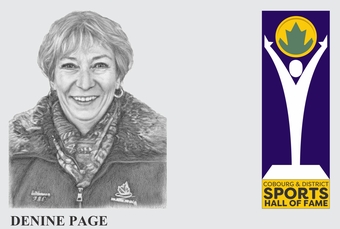

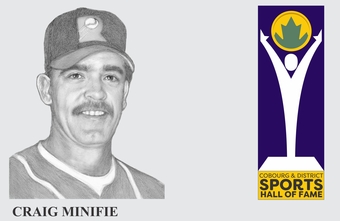
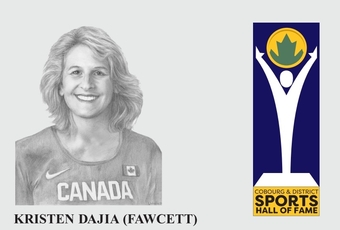
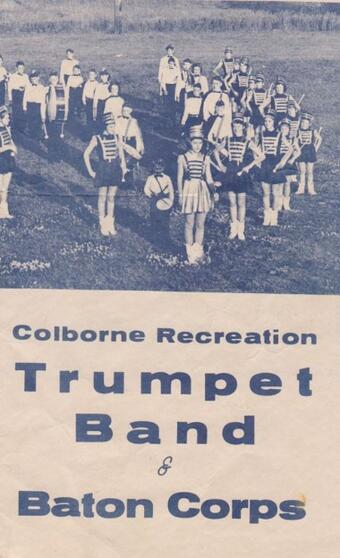


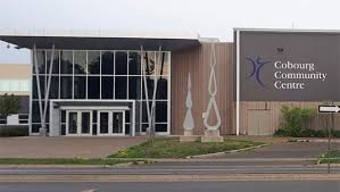
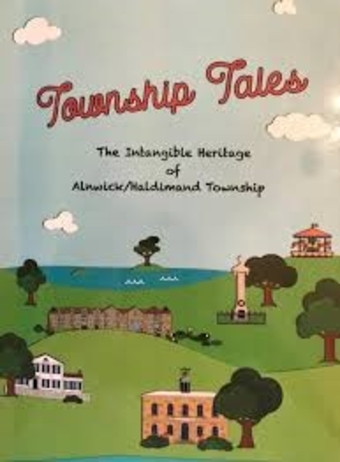
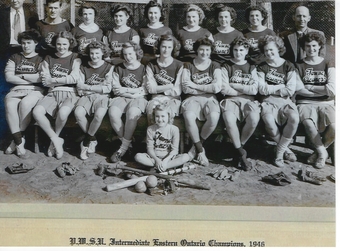

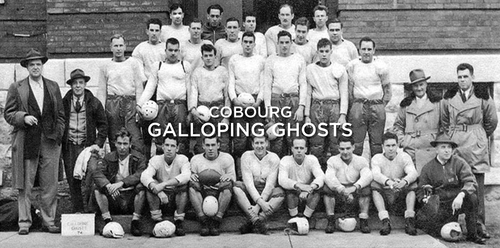

Sports in 1920/1930’s Men or Women
My grandparents were Thornton, Toey Ibey and my grandmother was Marion Clapper Ibey, sister of hockey player Dit Clapper. Marion was in Womens softball in Cobourg and Toey was a pitcher in the men’s. Looking for stories and pictures from that time.